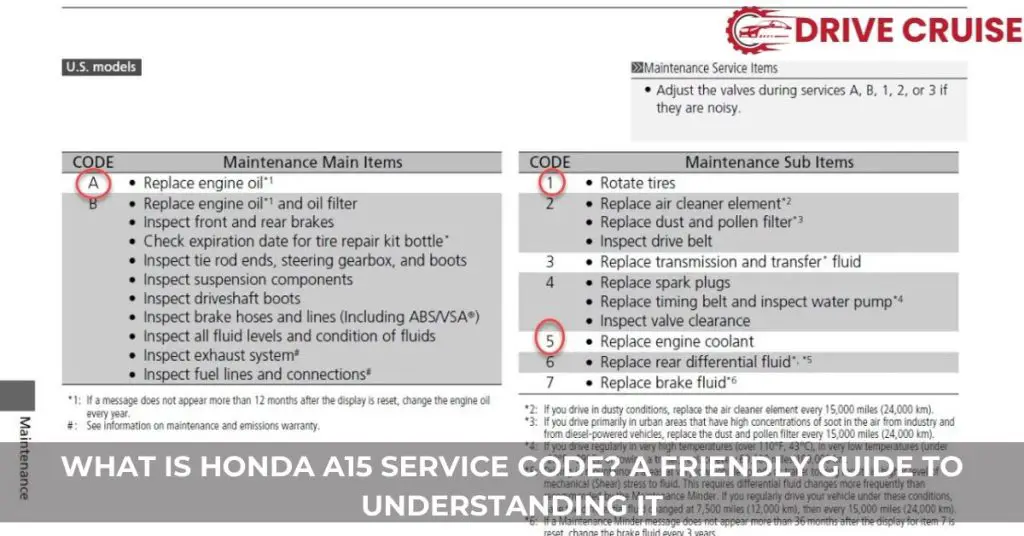If you’re a Honda owner, you’ve probably seen a variety of service codes pop up on your dashboard. But when the A15 service code lights up, it’s easy to be left scratching your head. What exactly does it mean? We’re here to demystify this for you.
The A15 service code is more than just a random combination of letters and numbers; it’s a direct line of communication from your car, telling you what it needs to keep running smoothly. Understanding this code is crucial for maintaining your vehicle’s health and ensuring a smooth ride. So, let’s dive into the world of Honda service codes together, starting with the A15. Join us as we explore what this code signifies and why it’s important for your car’s maintenance.
Understanding the Honda A15 Service Code
Decoding the A15 service code on a Honda dashboard is crucial for vehicle maintenance. This specific code is a combination of three distinct maintenance tasks that Honda recommends for optimal vehicle performance. Let’s break down what each letter and number in the code signifies.
- A in the A15 code stands for an oil change. Regular oil changes are vital for keeping the engine running smoothly and efficiently, ensuring that all moving parts are well lubricated and reducing wear over time.
- The first 1 in the A15 code indicates the need for a tire rotation. This process involves changing the position of the tires on the vehicle. Tire rotation helps to achieve uniform wear across all tires, extending their life and maintaining balanced handling and traction.
- The 5 in the A15 code refers to the replacement of the engine coolant. Engine coolant, or antifreeze, plays a critical role in preventing the car’s engine from overheating. Over time, coolant loses its effectiveness and needs replacing to keep the engine at an optimal operating temperature.
Understanding and acting upon the Honda A15 service code ensures the longevity and reliability of your vehicle. Regular maintenance, as signaled by such codes, helps identify potential problems early, potentially saving time and money on more significant repairs down the line. Always consult your Honda’s owner manual or a professional mechanic for the best maintenance practices.
Components of the A15 Service Code
Diving deeper into the A15 service code, it’s essential to break down each component to ensure every Honda owner grasps what their vehicle requires for optimum performance. The intricacies of this code help maintain the vehicle’s longevity and reliability, emphasizing its role in the vehicle’s maintenance routine. Here, we’ll explore each aspect individually to ensure clarity and understanding.
Oil Change (‘A’)
The ‘A’ in the A15 code signifies the need for an oil change, a fundamental aspect of vehicle maintenance. Regular oil changes protect the engine by ensuring it runs smoothly and efficiently. They involve removing the old, contaminated oil and replacing it with fresh oil. This process helps in reducing friction, cooling engine components, and removing wear particles and sludge. For most Honda vehicles, the manufacturer recommends synthetic oil for its superior quality and longer life span.
Tire Rotation (‘1’)
Following ‘A’, the ‘1’ emphasizes the need for tire rotation, a procedure that extends the life of tires and promotes even tire wear. Rotating tires involves changing their positions on the vehicle, such as moving the front tires to the rear and vice versa. This practice ensures that all tires wear evenly, leading to improved handling and traction, and ultimately reducing the risk of tire failure. Honda recommends tire rotation approximately every 7,500 miles or during every oil change for convenience.
Engine Coolant Replacement (‘5’)
The last digit, ‘5’, denotes engine coolant replacement. Engine coolant, or antifreeze, plays a pivotal role in your vehicle’s operation by regulating engine temperature. It prevents overheating in hot conditions and freezing in cold conditions. Replacing the engine coolant involves draining the old coolant from the radiator, flushing the system to remove any residual particles, and refilling it with new coolant. This process maintains optimal engine temperature, prevents corrosion, and keeps the cooling system running efficiently. Honda suggests checking the coolant level regularly and replacing it according to the guidelines in the owner’s manual.
Understanding these components helps Honda owners recognize the importance of the A15 service code in their vehicle maintenance schedule. Each element, from oil changes and tire rotations to engine coolant replacement, contributes to the vehicle’s performance and safety. Therefore, adhering to this maintenance code not only maximizes the lifespan of the vehicle but also ensures a smoother and safer driving experience.
The Importance of A15 Service
Understanding the A15 service code is paramount for Honda owners aiming to keep their vehicles in pristine condition. This code not only signifies when specific maintenance tasks need attention but also plays a crucial role in the vehicle’s overall health and efficiency. Let’s delve into why adhering to the A15 service schedule is so essential.
First, regular oil changes, indicated by the ‘A’ in the A15 code, are fundamental to an engine’s longevity. Oil lubricates moving parts, reduces friction, and helps to keep the engine clean by preventing buildup of harmful substances. Failing to replace oil at the recommended intervals can lead to increased wear and tear, potentially resulting in substantial engine damage.
Next, the ‘1’ signifies tire rotation, a procedure that ensures even tire wear. Consistent tire rotation improves road traction, enhances fuel efficiency, and extends the life of tires by distributing wear evenly across all four. This simple maintenance task can lead to significant savings by delaying the need for tire replacements and maintaining optimal driving performance.
Finally, the ‘5’ represents the replacement of engine coolant, a critical but often overlooked aspect of vehicle maintenance. Coolant prevents overheating by dissipating heat from the engine and protects against freezing in cold temperatures. Over time, coolant can become acidic, leading to corrosion and damage to the cooling system. Replacing the engine coolant as part of the A15 service ensures the system works effectively, preventing overheating and engine damage.
Each component of the A15 service code addresses a specific maintenance need that’s crucial for the safety, performance, and longevity of your Honda. Regular adherence to this service schedule ensures your vehicle remains reliable, efficient, and ready for the road ahead. Keeping up with these maintenance tasks not only protects your investment but also provides peace of mind, knowing your Honda is in optimal condition.
How to Schedule Your A15 Service
Scheduling your A15 service for your Honda isn’t just about maintaining your vehicle’s health; it’s about ensuring its efficiency and safety too. This task, comprising oil changes, tire rotations, and engine coolant replacement, plays a pivotal role in your Honda’s longevity. Here’s how to go about scheduling this essential service.
First, check your Honda’s owner’s manual for the recommended interval for the A15 service. Honda designs its vehicles to communicate maintenance needs effectively through these service codes, and adhering to the recommended schedule is crucial for optimal vehicle performance.
Next, contact your local Honda dealership or a trusted automotive service provider. Many dealerships offer convenient online scheduling tools on their websites, allowing you to select your preferred date and time for service without having to call. If you prefer, making a phone call can provide a more personalized experience, allowing you to ask questions and discuss any specific concerns with a service advisor.
Remember, scheduling your service ahead of time can provide several benefits. It ensures availability on your preferred date, allows the service center to prepare for your specific needs, and often, you’ll receive reminders as your service date approaches. This is particularly helpful in staying on top of your vehicle’s maintenance needs.
For those with busy schedules, look for service centers that offer additional conveniences, such as loaner vehicles, shuttle services, or comfortable waiting areas with Wi-Fi. These amenities can make the necessity of vehicle maintenance less of an inconvenience, fitting more easily into your busy life.
Lastly, when scheduling your A15 service, inquire about any ongoing promotions or service specials. Many Honda dealerships offer discounts on bundled services like the A15 package, potentially saving you money while ensuring your vehicle remains in peak condition.
By following these steps to schedule your A15 service, you’re taking an important step in prolonging the life and performance of your Honda. It’s a proactive approach to vehicle maintenance that can save you time and money in the long run.
Cost Considerations for A15 Service
Understanding the financial aspect of the A15 service for Honda vehicles helps us manage our maintenance budget effectively. Typically, the cost can vary significantly based on the dealership or service center, geographical location, and the specific model of the vehicle. Here, we’ll delve into the factors that influence the cost and offer insights into how to estimate your expenses.
First, dealership prices often differ from those at independent service centers. Dealerships might charge more due to the specialized knowledge of their technicians and the use of OEM (Original Equipment Manufacturer) parts. On the other hand, independent service centers may offer competitive rates but it’s crucial to ensure they have experience with Honda vehicles.
Geographical location plays a considerable role in determining the cost. Labor rates can vary widely across different states and cities, affecting the overall service cost.
The model of your Honda vehicle also impacts the price. Newer or high-end models might require more expensive parts or specialized labor, contributing to a higher service cost.
To estimate the cost of an A15 service, it’s advisable to contact several service providers for quotes. Clarify what’s included in their A15 service package to make an accurate comparison. Don’t forget to inquire about specials or discounts, as many dealerships offer deals on routine maintenance, which can significantly reduce the price.
Moreover, consider the long-term benefits of adhering to the recommended A15 service schedule. Regular maintenance might seem like a constant expense, but it can prevent costly repairs in the future, enhance your vehicle’s performance, and even improve its resale value.
By being informed and proactive, we can navigate the cost considerations of A15 service with ease, ensuring our Honda vehicles remain in top condition without breaking the bank.
Conclusion
We’ve covered the essentials of the Honda A15 service code and why it’s crucial for maintaining your vehicle’s health. Understanding the financial aspects can help us budget better and avoid surprises when it’s time for service. We’ve also seen how costs can vary, so it’s wise to shop around and ask the right questions. By staying informed and proactive, we can ensure our Hondas continue to run smoothly and retain their value over time. Let’s keep our vehicles in peak condition by adhering to the A15 service schedule. It’s all about smart maintenance for long-term benefits.
Related Posts:
- What is Honda A1 Service Code and How to Understand It
- What is Honda A13 Service Code: A Friendly Guide
- What is Honda A15 Service Code? A Friendly Guide to Understanding It
- What is Honda A123 Service Code? A Friendly Guide to Understanding Honda Maintenance Codes
- What Is Honda A137 Service Code? Your Quick Guide to Understanding It
- What is Honda B12 Service Code: A Friendly Guide
- What is Honda B123 Service Code? A Friendly Guide to Understanding Maintenance Codes
- What is Honda B125 Service Code: A Beginner’s Guide
- What is Honda B135 Service Code? A Friendly Guide to Understanding It
- What is Honda B137 Service Code? A Friendly Guide to Understanding Your Honda’s Maintenance Needs







